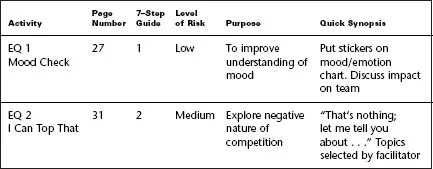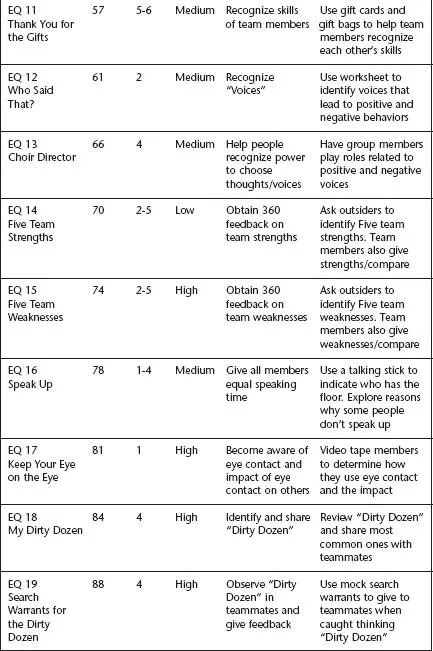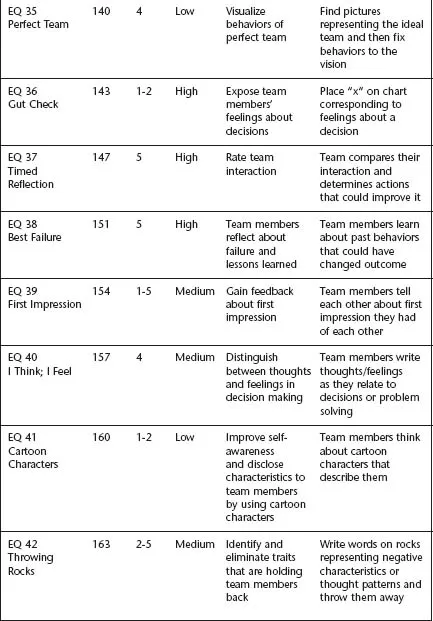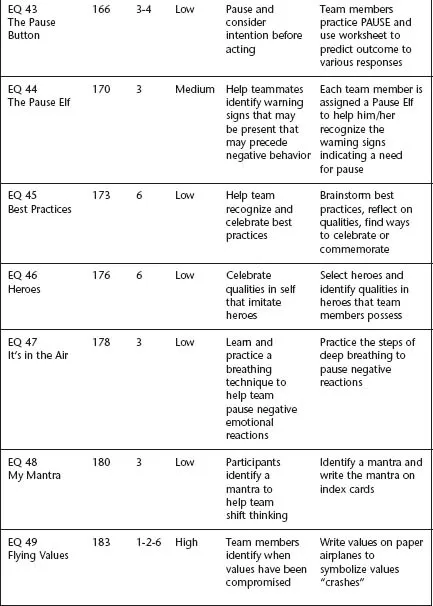![]()
CHAPTER 1
A GUIDE TO THE 50 ACTIVITIES
Table 1-1 is designed to help you determine the appropriate activity for your next team meeting. For each activity, the table indicates the appropriate step(s) in the 7-Step Guide, the Level of Risk, the Purpose, and a Quick Synopsis, so you can decide at a glance which activity best suits your objective. We advise that you begin with some low-risk activities that will help your team become familiar with the concepts of emotional intelligence. For more information about selecting activities, see Chapter 3.
TABLE 1-1 50 Activities: A Quick Overview
![]()
CHAPTER 2
WHAT YOU'LL SEE FOR EACH ACTIVITY
To simplify your choice and help you effectively implement the activities, the descriptions of the activities are consistently divided into the following categories. Not all activities contain all of these categories. For example, if an activity does not have any variations or any cautions, these categories will not appear.
Level of Risk
Each activity is marked as “Low, Medium, or High” to designate its level of risk. By level of risk, we are referring to the level of disclosure that is involved in the activity. Some activities require very little self-disclosure; others require much more. Of course, the more disclosure, the greater the risk for some individuals. It is recommended that the leader or facilitator begin with activities that are low in risk and require little self-disclosure. Once the level of trust of the team increases, the leader can introduce activities that are higher in risk. Although each team is different, the level of difficulty is gauged based on our experience with most groups. Of course, the leader will need to use discretion to determine the comfort level of his or her group. However, just because something might be difficult to address does not mean it should be avoided. Some of the most fruitful activities may be when participants are asked to address difficult topics such as team conflict. It will be important for the leader/facilitator to feel comfortable with the discussion and to create a safe environment for such topics to be addressed.
Purpose
The purpose states what the activity is intended to achieve. It helps the leader/facilitator decide if the activity is the best activity to achieve the desired objective. It gives a brief understanding of the basic concept that the activity is designed to teach. Once the activity is selected, the leader/facilitator should state the purpose to the team, so the team understands what the objective is.
Why Is This Important?
To help the facilitator connect the main concepts of the activity to the team's functioning, this section explains why the concept is important. This information should be used in introducing the activity to the team. Understanding why an activity is useful is very important to people. It serves to give the group the big picture. Adults are much more likely to engage in the learning if they understand why it is important. So, take the time to explain this step.
When to Use This Activity
Each activity includes some suggestions that will help the leader/ facilitator determine if the activity is useful for his or her team. It may also give the leader/facilitator new ways to think about the interaction skills of his or her team.
Set the Stage
The leader will be required to introduce each activity to the team. During this period, the leader/facilitator must explain the purpose of the activity and why the concept is important. The leader/facilitator may also be required to explain the concept in a little more depth or provide examples of how the concept relates to work. Sometimes, setting the stage requires the leader to ask a thought provoking question; other times, it requires some simple explanation of a concept or terminology. This step is important in preparing the team for the learning activity, and will help frame the activity for the group so that the maximum learning can occur. For more background information, The EQ Difference should be consulted.
Materials
This section lists materials that will be needed to successfully execute the activity. Most activities require no materials or simple materials that are readily available. If a handout is required, it is provided at the end of the activity. It's always useful to have a flip chart and markers handy. Also, it is assumed that the team will be seated at a table.
The Activity
This section gives a step-by-step description of the activity for the leader/facilitator. It explains what the leader should do to conduct the activity.
Key Questions
The key questions are essential for the success of the activity, as they will facilitate learning. They also link the learning to the job, thereby making the learning practical. It is important that the leader/facilitator focus on this debrief period to have a successful outcome. Although we've captured some of the important debrief questions, the leader/ facilitator may want to add questions that would be relevant, based on the group and the discussion. For more information on using the key questions, please refer to the section “How to Use This Book—After the Activity” in Chapter 3.
A Word of Caution
This section gives useful advice to the leader/facilitator regarding how to avoid specific problems when facilitating the activity. It gives the leader/facilitator a “heads up” on what can go wrong and what to do about it before it becomes a problem. Also contained in this section are some cautions about when the activity may not be successful. This section is based on the experience of other leaders and facilitators who have used the activity and could be very useful, especially to a novice facilitator.
Variation
Many of the activities in this book can be altered slightly depending on the team's situation. This section contains some suggested variations that could be useful. These variations are based on the experience of other facilitators and leaders. Deviating too far from the activity may not produce the desired outcome, so unless you are an experienced facilitator, we do not recommend too much variation.
Ask for Commitment
The leader/facilitator should ask the team members what they are willing to do back on the job with the information that was gained from the activity. It's important that the facilitator keep the goal in mind, as the goal of this entire book is to improve team interactions on the job. By asking, after each activity, what commitment people are willing to make, the leader/facilitator keeps the group focused on the importance of teamwork and how everyone's actions can contribute to improved teamwork.
![]()
CHAPTER 3
HOW TO USE THIS BOOK
Before the Activity
Every activity is different. Every team is different. Every team leader is different. As the team leader/facilitator, it is important that you are well prepared and take into consideration your team, your location, and your team's interests, challenges, quirks, and so on. There is no pat answer to selecting the correct activity. There are no scripts to tell you exactly what to say or what examples to use. Because you know your team better than anyone else, you're the person who knows best what will work. However, by following just a few steps and having a willingness to improve, and an interest in improving, you can definitely successfully facilitate these activities. Here are some ideas to help you prepare before the activity.
1. Think about your team. What are its current challenges? What do you wish to accomplish with an activity? Do you want to broaden the team members’ awareness of their impact on one another? Are you trying to get team members to appreciate one another? Are your team members familiar with each other or are they strangers? Is your team experiencing conflict? Are some members dominating? The activities in this book are designed to address a variety of issues depending on the challenge your team is currently experiencing.
2. Select an activity. Use Chapter 1, “A Guide to the 50 Activities,” as a starting point. Then read the activity to see if it fits your objective. As the facilitator, you should select activities that you think will work best with your team. The activity you select will depend on many factors, including how long your team has been together, the personalities of your team members, and what types of issues your team is currently addressing. Although you may want to begin with activities that you know your team would enjoy, stretching and using more challenging activities that involve greater risk is also encouraged.
3. Read the activity several times. Make sure you can visualize the activity as you read it. You should be well prepared. Nothing kills an activity like a leader who doesn't know or understand how the activity is supposed to work. Be sure you can anticipate what's supposed to happen.
4. Think about how you will present the activity and about any personal examples you may wish to use to make the activity relevant. Be sure to include the information in the “Purpose,” “Why Is This Important?,” and “Setting the Stage” categories in the activity write-up. When using personal examples, never point out problems among team members as an example of why this activity is important or what the activity can accomplish. Instead, talk about your personal learning or vulnerability related to the concept. If you expect team members to be candid and learn to improve their self-awareness, you need to speak about yourself as a “work in progress.”
5. Think about your role in the activity. What role will the activity require of you? Will you be a coach, a timekeeper, an enforcer? Be prepared to play the role that is required to make the exercise a success. Think about what you will say and how you will sound to properly facilitate the exercise.
6. Gather materials. Most of these activities require few or no materials. However, it will be necessary for you to prepare in advance any materials that will be used for the activities. Prepare handouts ahead of time, and be sure that you have enough for all team members.
7. Set up the room. How will the chairs be arranged? Will you need a flip chart? If the instructions are le...








